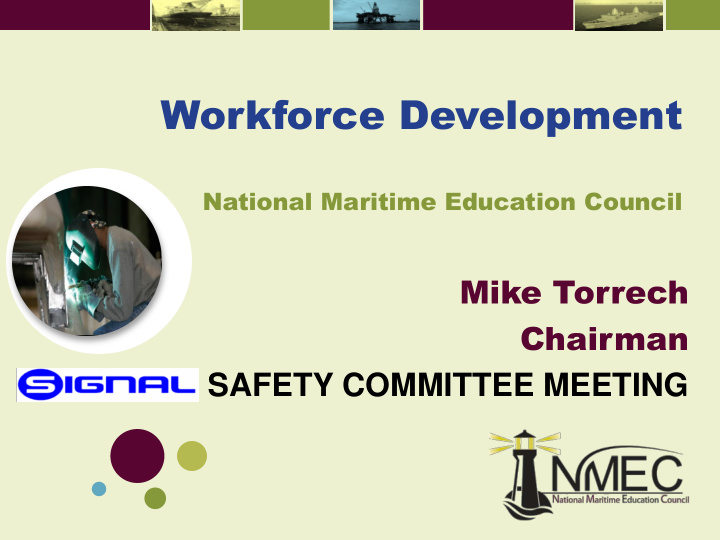



Workforce Development National Maritime Education Council Mike Torrech Chairman SAFETY COMMITTEE MEETING
ABOUT NMEC • Mission • To lead the Maritime industry in the development, promotion, and implementation of standardized craft training processes. • Who We Are • A collaborative, multi-regional, industry-centered national organization made up of industry leaders/decision makers
Current NMEC Membership • ATN • Continental Maritime • GSSC • VT Halter Marine • Bollinger • Virginia Ship Repair • Ingalls • Newport News • American Maritime Holdings • ABS • Wesco • AWS • Signal • NCCER • Ameriforce • NSC Technologies • FMT Shipyard
Workforce Development • What We Want: • Highly skilled craft professionals who can perform high quality work at the lowest possible cost • Curriculum Plan: – Welders – Shipfitters – Pipefitters – Machinists – Marine Electricians – Sheet Metal Personnel – Coatings Personnel – Riggers / Crane Operators / Equipment Operators
Why Training? The Construction Industry Institute (CII) study assumes an investment of 1.0% of the total project budget for wages / labor SOURCE: Construction Industry Institute (CII). RT231- 1 “Construction Industry Craft Training in the United States & Canada” (Aug 2007)
Why Standardize Training? • What We Propose: – Set of industry definitions that define the core of what a particular craft does and defines the competencies that are required to meet that definition – Curriculum that teaches those core competencies – Structured instructional system that ensures that curriculum is taught consistently – Assessments that ensure learning has taken place and ensure the integrity of the system – Credentialing that allows employers to ensure they are hiring knowledgeable individuals – Readily available through existing educational/training portals.
Why Industry Cares About Credentialing • Certifies that the individual has completed preferred course of study & performance • Provide recognition and esteem for the craft professional • Credentialing is a gateway to much of the educational enablers – Pell Grants – Student Loans
NMEC Program • Curriculum developed utilizing best practices as defined by multiple company Subject Matter Experts. – Formal process/multiple reviews by industry • Multiple Training Venues – Technical Colleges – Community Colleges – High School CareerTech – Company Sponsored Programs – Trade Associations
Program Elements • Completion of program allows credentialing – Credentialed programs are accredited • Instructors must be trained/certified • Training facilities must be certified – Assessment centers • Credentialed • Results monitored • Programmatics ensure the integrity of the system
Details • Becoming an accredited training facility allows your employees to become credentialed. – Use of curriculum does not require you to credential your personnel – You may use curriculum and not teach all elements • System is widely used in the United States across a wide spectrum of educational and training institutions.
Curriculum Detail • Maritime Core (Available Now) • Pipefitter 1 (Available Now) • Pipefitter 2 (Available Now) • Structural / Shipfitter 1 (Available June 2014) • Structural / Shipfitter 2 (Available June 2014) • Structural / Shipfitter 3 (Available June 2015) • Maritime Core Assessment
OUR PARTNER • NCCER • Not-for-profit education foundation • Established in 1995 by the construction industry to 1. Develop industry-driven, standardized craft training programs with portable credentials 2. Address critical workforce shortages 3. Reduce training costs/improve outcomes Mission: To build a safe, productive, and sustainable workforce of craft professionals
WHY NCCER? • Established National Network • Accredited training providers • Master Trainers / Certified Instructors • Established curricula development system • Accredited assessment centers • Registry of credentialed craft professionals • COMPLETE WFD PROCESS – 20 year head start Mission: To build a safe, productive, and sustainable workforce of craft professionals
NCCER – UTILIZED IN ALL 50 STATES • 850+ organizations • (accredited and pending) • 6,000+ schools/training center locations • Additional international programs
NMEC MEMBERSHIP REQUIREMENTS • Financial investment based on company size • Active participation in NMEC meetings • Support of curricula/assessment activities • Provide SME’s • Supply instructional resources • Photographs • Videos • Websites • Textbooks • Other
WHY NMEC? • The leader for maritime workforce development! • Maritime career awareness and recruiting • WFD best practice gathering and deployment • Development of a world class maritime curriculum • Program standardization and accreditation • Craft professional assessment and certification • Skill upgrade programs • Management / leadership development
INVESTMENT LEVELS • Shipbuilding, Ship Repair, Offshore Marine, and Skilled Trade Providers • Tier 1 (employing over 2,000*) $60K • Tier 2 (employing 1,000-2,000*) $40K • Tier 3 (employing 500-999*) $20K • Tier 4 (employing 250-500*) $10K • Tier 5 (employing under 250*) $5K • Affiliates • Regional/National Trade Associations, Equipment Manufacturers, Suppliers, etc… • Platinum $20K • Gold $10K • Silver $5K *Employee count based on annual average number of full-time employees. We’ve waited long enough…invest today!
Recommend
More recommend